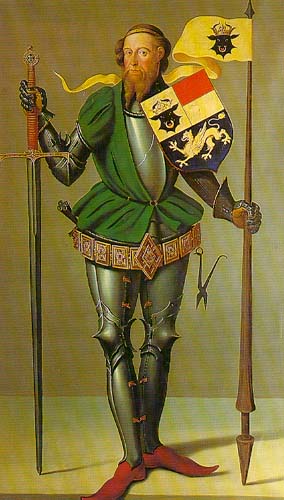Albert II, Duke of Mecklenburg facts for kids
Quick facts for kids
Albert II, Duke of Mecklenburg
|
|
|---|---|

Portrait of Duke Albert II of Mecklenburg
|
|
| Born | c. 1318 |
| Died | 18 February 1379 |
| Noble family | House of Mecklenburg |
| Spouse(s) | Euphemia of Sweden Adelheid of Hohenstein |
| Issue | Henry Albert Magnus Ingeborg Anna |
| Father | Henry II, Lord of Mecklenburg |
| Mother | Anna of Saxe-Wittenberg |
Albert II, Duke of Mecklenburg (around 1318 – February 18, 1379) was an important leader in northern Germany. His lands were located near the Baltic Sea. He was the head of the House of Mecklenburg, a powerful family. His main home and ruling center was in Schwerin starting in the 1350s.
Life of Duke Albert II
Albert was born in Schwerin around 1318. He was the oldest son of Lord Henry II of Mecklenburg. His mother was Princess Anna of Saxe-Wittenberg. His family was an old princely family from the region.
Albert became the Prince (or Lord) of Mecklenburg in 1329 after his father passed away. He was very interested in gaining power and wealth in Scandinavia. This included getting lands or money there. In 1348, the Holy Roman Emperor Charles IV made Mecklenburg a Duchy. This meant Albert, along with his younger brother John, became the first Dukes of Mecklenburg.
Family and Power
On April 10, 1336, Albert married Euphemia of Sweden and Norway. She was a relative and an important heir from Scandinavia. Her father was Eric of Sweden. Her mother was Princess Ingeborg of Norway, the only daughter of King Haakon V of Norway.
Through this marriage, Albert gained influence in Sweden. He got lands and important family connections. This allowed him to get involved in the politics of Scandinavia. The Swedes gave Albert the nickname "The Fox of Mecklenburg." This was because they thought he was clever and sometimes greedy.
Albert planned for his oldest son, Henry, to marry Ingeborg. She was the oldest daughter of King Valdemar IV of Denmark. Prince Henry married her around 1362. Their young son was later suggested as an heir to the Danish throne. However, he faced competition from King Valdemar's youngest daughter, Margaret. She later became a powerful ruler of the Kalmar Union.
Swedish Throne Involvement
Albert's brother-in-law, King Magnus IV of Sweden, faced many problems in the 1350s. Powerful nobles in Sweden wanted to limit the king's power. They even tried to make Magnus's own son, Eric, a rival king. After young Eric died, Albert's second son, also named Albert, became the next choice for the nobles.
Duke Albert worked hard to make his son the King of Sweden. He wanted to be the real power behind the throne. The younger Albert eventually removed his uncle Magnus IV from the Swedish throne. He then became King Albert of Sweden.
Even during Albert and Euphemia's lives, people knew that her family background would be important. It could lead to future claims to the thrones of Scandinavia.
After his first wife died, Duke Albert married a second time. His second wife was Countess Adelheid of Hohenstein. They did not have any children together.
Duke Albert had five children who survived from his marriage with Euphemia. These were his sons Henry, Albert, and Magnus. His daughters were Ingeborg and Anna.

